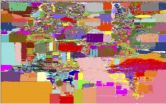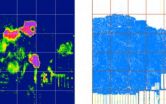(Press-News.org) From their origins in the 1940s as sequestered, room-sized machines designed for military and scientific use, computers have made a rapid march into the mainstream, radically transforming industry, commerce, entertainment and governance while shrinking to become ubiquitous handheld portals to the world.
This progress has been driven by the industry's ability to continually innovate techniques for packing increasing amounts of computational circuitry into smaller and denser microchips. But with miniature computer processors now containing millions of closely-packed transistor components of near atomic size, chip designers are facing both engineering and fundamental limits that have become barriers to the continued improvement of computer performance.
Have we reached the limits to computation?
In a review article in this week's issue of the journal Nature, Igor Markov of the University of Michigan reviews limiting factors in the development of computing systems to help determine what is achievable, identifying "loose" limits and viable opportunities for advancements through the use of emerging technologies. His research for this project was funded in part by the National Science Foundation (NSF).
"Just as the second law of thermodynamics was inspired by the discovery of heat engines during the industrial revolution, we are poised to identify fundamental laws that could enunciate the limits of computation in the present information age," says Sankar Basu, a program director in NSF's Computer and Information Science and Engineering Directorate. "Markov's paper revolves around this important intellectual question of our time and briefly touches upon most threads of scientific work leading up to it."
The article summarizes and examines limitations in the areas of manufacturing and engineering, design and validation, power and heat, time and space, and information and computational complexity.
"What are these limits, and are some of them negotiable? On which assumptions are they based? How can they be overcome?" asks Markov. "Given the wealth of knowledge about limits to computation and complicated relations between such limits, it is important to measure both dominant and emerging technologies against them."
Limits related to materials and manufacturing are immediately perceptible. In a material layer ten atoms thick, missing one atom due to imprecise manufacturing changes electrical parameters by ten percent or more. Shrinking designs of this scale further inevitably leads to quantum physics and associated limits.
Limits related to engineering are dependent upon design decisions, technical abilities and the ability to validate designs. While very real, these limits are difficult to quantify. However, once the premises of a limit are understood, obstacles to improvement can potentially be eliminated. One such breakthrough has been in writing software to automatically find, diagnose and fix bugs in hardware designs.
Limits related to power and energy have been studied for many years, but only recently have chip designers found ways to improve the energy consumption of processors by temporarily turning off parts of the chip. There are many other clever tricks for saving energy during computation. But moving forward, silicon chips will not maintain the pace of improvement without radical changes. Atomic physics suggests intriguing possibilities but these are far beyond modern engineering capabilities.
Limits relating to time and space can be felt in practice. The speed of light, while a very large number, limits how fast data can travel. Traveling through copper wires and silicon transistors, a signal can no longer traverse a chip in one clock cycle today. A formula limiting parallel computation in terms of device size, communication speed and the number of available dimensions has been known for more than 20 years, but only recently has it become important now that transistors are faster than interconnections. This is why alternatives to conventional wires are being developed, but in the meantime mathematical optimization can be used to reduce the length of wires by rearranging transistors and other components.
Several key limits related to information and computational complexity have been reached by modern computers. Some categories of computational tasks are conjectured to be so difficult to solve that no proposed technology, not even quantum computing, promises consistent advantage. But studying each task individually often helps reformulate it for more efficient computation.
When a specific limit is approached and obstructs progress, understanding the assumptions made is key to circumventing it. Chip scaling will continue for the next few years, but each step forward will meet serious obstacles, some too powerful to circumvent.
What about breakthrough technologies? New techniques and materials can be helpful in several ways and can potentially be "game changers" with respect to traditional limits. For example, carbon nanotube transistors provide greater drive strength and can potentially reduce delay, decrease energy consumption and shrink the footprint of an overall circuit. On the other hand, fundamental limits--sometimes not initially anticipated--tend to obstruct new and emerging technologies, so it is important to understand them before promising a new revolution in power, performance and other factors.
"Understanding these important limits," says Markov, "will help us to bet on the right new techniques and technologies."
INFORMATION:
Can our computers continue to get smaller and more powerful?
University of Michigan computer scientist reviews frontier technologies to determine fundamental limits of computer scaling
2014-08-13
ELSE PRESS RELEASES FROM THIS DATE:
UT Arlington team's work could lead to earlier diagnosis, treatment of mental diseases
2014-08-13
A computer science and engineering associate professor and her doctoral student graduate are using a genetic computer network inference model that eventually could predict whether a person will suffer from bipolar disorder, schizophrenia or another mental illness.
The findings are detailed in the paper "Inference of SNP-Gene Regulatory Networks by Integrating Gene Expressions and Genetic Perturbations," which was published in the June edition of Biomed Research International. The principal investigators were Jean Gao, an associate professor of computer science and engineering, ...
Three radars are better than one: Field campaign demonstrates two new instruments
2014-08-13
Putting three radars on a plane to measure rainfall may seem like overkill. But for the Integrated Precipitation and Hydrology Experiment field campaign in North Carolina recently, more definitely was better.
The three instruments, developed by the High Altitude Radar group at NASA's Goddard Space Flight Center in Greenbelt, Maryland, flew as part of the Global Precipitation Measurement (GPM) mission's six-week ground-validation program that took place May 1 through June 15 in the southern Appalachians, specifically to measure rain in difficult-to-forecast mountain regions. ...
New material could enhance fast and accurate DNA sequencing
2014-08-13
CHAMPAIGN, Ill. — Gene-based personalized medicine has many possibilities for diagnosis and targeted therapy, but one big bottleneck: the expensive and time-consuming DNA-sequencing process.
Now, researchers at the University of Illinois at Urbana-Champaign have found that nanopores in the material molybdenum disulfide (MoS2) could sequence DNA more accurately, quickly and inexpensively than anything yet available.
"One of the big areas in science is to sequence the human genome for under $1,000, the 'genome-at-home,'" said Narayana Aluru, a professor of mechanical ...
Patent examiners more likely to approve marginal inventions when pressed for time
2014-08-13
CHAMPAIGN, Ill. — Haste makes waste, as the old saying goes. And according to research from a University of Illinois expert in patent law, the same adage could be applied to the U.S. Patent and Trademark Office, where high-ranking examiners have a tendency to rubber-stamp patents of questionable merit due to time constraints.
The less time patent examiners are given to review an application, the more likely they are to grant patent protection to inventions "on the margin," says a study co-authored by Melissa Wasserman, the Richard and Anne Stockton Faculty Scholar and ...
Bones from nearly 50 ancient flying reptiles discovered
2014-08-13
Scientists discovered the bones of nearly 50 winged reptiles from a new species, Caiuajara dobruskii, that lived during the Cretaceous in southern Brazil, according to a study published August 13, 2014 in the open-access journal PLOS ONE by Paulo Manzig from Universidade do Contestado, Brazil, and colleagues.
The authors discovered the bones in a pterosaur bone bed in rocks from the Cretaceous period. They belonged to individuals ranging from young to adult, with wing spans ranging from 0.65-2.35m, allowing scientists to analyze how the bones fit into their clade, but ...
Embalming study 'rewrites' chapter in Egyptian history
2014-08-13
The origins of mummification may have started in ancient Egypt 1,500 years earlier than previously thought, according to a study published August 13, 2014 in the open-access journal PLOS ONE by Stephen Buckley from University of York and colleagues from Macquarie University and University of Oxford.
Previous evidence suggests that between ~4500 B.C. and 3100 B.C., Egyptian mummification consisted of bodies desiccating naturally through the action of the hot, dry desert sand. The early use of resins in artificial mummification has, until now, been limited to isolated occurrences ...
Little penguins forage together
2014-08-13
Most little penguins may search for food in groups, and even synchronize their movements during foraging trips, according to a study published August 13, 2014 in the open-access journal PLOS ONE by Maud Berlincourt and John Arnould from Deakin University in Australia.
Little penguins are the smallest penguin species and they live exclusively in southern Australia, New Zealand, and the Chatham Islands, but spend most of their lives at sea in search of food. Not much is known about group foraging behavior in seabirds due to the difficulty in observing their remote feeding ...
Young blue sharks use central North Atlantic nursery
2014-08-13
Blue sharks may use the central North Atlantic as a nursery prior to males and females moving through the ocean basin in distinctly different patterns, according to a study published August 13, 2014 in the open-access journal PLOS ONE by Frederic Vandeperre from University of the Azores, Portugal, and colleagues.
Shark populations typically organize by location and separate by sex and size, but these patterns remain poorly understood, particularly for exploited oceanic species such as the blue shark. The authors of this study employed a long-term electronic tagging experiment ...
Bacterial biosurgery shows promise for reducing the size of inoperable tumors
2014-08-13
Kansas City, MO. — Deep within most tumors lie areas that remain untouched by chemotherapy and radiation. These troublesome spots lack the blood and oxygen needed for traditional therapies to work, but provide the perfect target for a new cancer treatment using bacteria that thrive in oxygen-poor conditions. Now, researchers have shown that injections of a weakened version of one such anaerobic bacteria -- the microbe Clostridium novyi -- can shrink tumors in rats, pet dogs, and a human patient.
The findings from BioMed Valley Discoveries and a nationwide team of collaborators ...
Embalming study 'rewrites' key chapter in Egyptian history
2014-08-13
Researchers from the Universities of York, Macquarie and Oxford have discovered new evidence to suggest that the origins of mummification started in ancient Egypt 1,500 years earlier than previously thought.
The scientific findings of an 11-year study by a researcher in the Department of Archaeology at York, and York's BioArCh facility, and an Egyptologist from the Department of Ancient History at Macquarie University, push back the origins of a central and vital facet of ancient Egyptian culture by over a millennium.
Traditional theories on ancient Egyptian mummification ...
LAST 30 PRESS RELEASES:
iPS cells from dish to freezer and back
Deep neural networks enable accurate pricing of American options under stochastic volatility
Collective risk resonance in Chinese stock sectors uncovered through higher-order network analysis
Does CPU impact systemic risk contributions of Chinese sectors? Evidence from mixed frequency methods with asymmetric tail long memory
General intelligence framework to predict virus adaptation based on a genome language model
Antibiotic resistance is ancient, ecological, and deeply connected to human activity, new review shows
Vapes, pouches, heated tobacco, shisha, cigarettes: nicotine in all forms is toxic to the heart and blood vessels
From powder to planet: University of Modena engineers forge a low-carbon future for advanced metal manufacturing
Super strain-resistant superconductors
Pre-school health programme does not improve children’s diet or physical activity, prompting call for policy changes, study finds
Autumn clock change linked to reduction in certain health conditions
AI images of doctors can exaggerate and reinforce existing stereotypes
Where medicine meets melody – how lullabies help babies and parents in intensive care
We may never be able to tell if AI becomes conscious, argues philosopher
AI video translation shows promise but humans still hold the edge
Deep ocean earthquakes drive Southern Ocean’s massive phytoplankton blooms, study finds
Without campus leftovers to pick through, the beaks of this bird changed shape during the pandemic
High-dose antibiotic does not reduce mortality in tuberculous meningitis
How many insects fly in the sky above the USA?
Could cheese protect your brain health?
Who faces more difficulty recovering from stroke?
Colliding galaxies create the brightest, fastest growing black holes at their center
New BrainHealth research reveals tradeoffs on sleep with cannabis use for chronic pain
Aging-US now on ResearchGate, enhancing visibility for authors and readers
'Molecular glue' stabilizes protein that inhibits development of non-small cell lung cancer
Mount Sinai Health System is recognized in 2025 Chime Digital Health Most Wired survey
From prey to predator: How carnivores spread beneficial fungi
Menopause symptoms may be frequent and have negative effects, according to female endurance athletes
US Congressmembers’ responses on X to mass shooting events differ along party lines
KAIST-UEL team develops “origami” airless wheel to explore lunar caves
[Press-News.org] Can our computers continue to get smaller and more powerful?University of Michigan computer scientist reviews frontier technologies to determine fundamental limits of computer scaling







